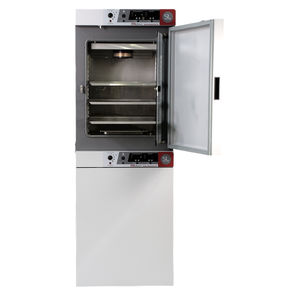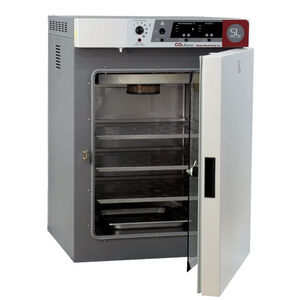
- Laboratory
- Laboratory infrastructure
- Forced convection laboratory incubator
- Sheldon Manufacturing
Thermoelectric laboratory incubator SRI3P forced convectionBODbenchtop
Add to favorites
Compare this product
Characteristics
- Type
- forced convection, thermoelectric
- Applications
- BOD
- Configuration
- benchtop
- Chamber material
- aluminum
- Number of doors
- 1-door
- Other characteristics
- cooling, low-temperature
- Temperature range
Min.: 15 °C
(59 °F)Max.: 40 °C
(104 °F)- Capacity
99 l
(26.2 gal)
Description
Model SRI3P B.O.D. Thermoelectric Cooled Incubator, 3.5 cu.ft. (84 Bottle) capacity. Using innovative thermoelectric cooling technology, the SRI3P eliminates the need for a refrigeration compressor. This means that these units use 71% less power than alternative models and reduce room air conditioning loads by 75%. They also include 35-pound capacity shelves, which eliminates sagging.
SRIP incubators meet APHA specifications for Biochemical Oxygen Demand (BOD) and include a mechanical convection system to ensure even air distribution, a digital temperature set controller, over-temperature limit control, and a digital temperature display.
A one-amp interior outlet allows the use of shakers, stirrers, roller bottles, or other apparatus. Units are supplied with adjustable leveling feet.
SHEL LAB Low-Temperature Incubators are ideal for testing sewage, wastewater, and other low and room temperature applications.
The SRI3P include:
P.I.D. Temperature Control
LED Display of Setpoint and Chamber Temperature
Interior Electrical Outlet
Door Ajar Alarm
Fan Assisted/Forced-Air Circulation
Aluminum Interior
24 Month Limited Warranty
Catalogs
No catalogs are available for this product.
See all of Sheldon Manufacturing‘s catalogsRelated Searches
- Laboratory incubator
- Heating furnace
- Laboratory furnace
- Benchtop laboratory incubator
- Temperature-control laboratory incubator
- Stainless steel laboratory incubator
- Benchtop furnace
- Laboratory workstation
- 1-door furnace
- Heated laboratory incubator
- Stainless steel furnace
- Drying furnace
- Forced air laboratory incubator
- Cooling laboratory incubator
- Carbon dioxide laboratory incubator
- Floor-standing laboratory incubator
- Microbiological laboratory incubator
- Benchtop laboratory workstation
- Cell culture laboratory incubator
- Compact laboratory incubator
*Prices are pre-tax. They exclude delivery charges and customs duties and do not include additional charges for installation or activation options. Prices are indicative only and may vary by country, with changes to the cost of raw materials and exchange rates.










